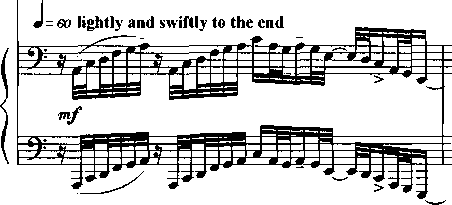125
Example 3.15: Viola Sonata, First mvt., mm. 109-111
molto rit

The “breathing” figure marks the transition into the coda. In this final section, the
pace quickens slightly with a repetition of the piano’s “country swing” material from m.
51 and 54 marked very lightly, and swiftly to the end in the score. Although the figure
was used twice earlier in the movement (see Example 3.13), it seems new here, starting
out with a fragment and then restarting for a more complete version of the motive, as
shown in Example 3.16.
Example 3.16: Viola Sonata, First mvt., m. 112

Except for the rising octave motive, echoed twice in the closing measures, the viola has
all new, almost entirely pentatonic material that sounds like it could have been influenced
by Dunham’s scat-singing in String Quartet: Schoenberg, Schenker, andSchillinger.
Although the passagework lies rather awkwardly in the viola, its function again seems to
be to capture the improvisatory feeling that has reappeared with several different melodic
More intriguing information
1. Portuguese Women in Science and Technology (S&T): Some Gender Features Behind MSc. and PhD. Achievement2. THE MEXICAN HOG INDUSTRY: MOVING BEYOND 2003
3. Strategic Investment and Market Integration
4. TLRP: academic challenges for moral purposes
5. The name is absent
6. Valuing Farm Financial Information
7. The name is absent
8. Do Decision Makers' Debt-risk Attitudes Affect the Agency Costs of Debt?
9. Weak and strong sustainability indicators, and regional environmental resources
10. Draft of paper published in: